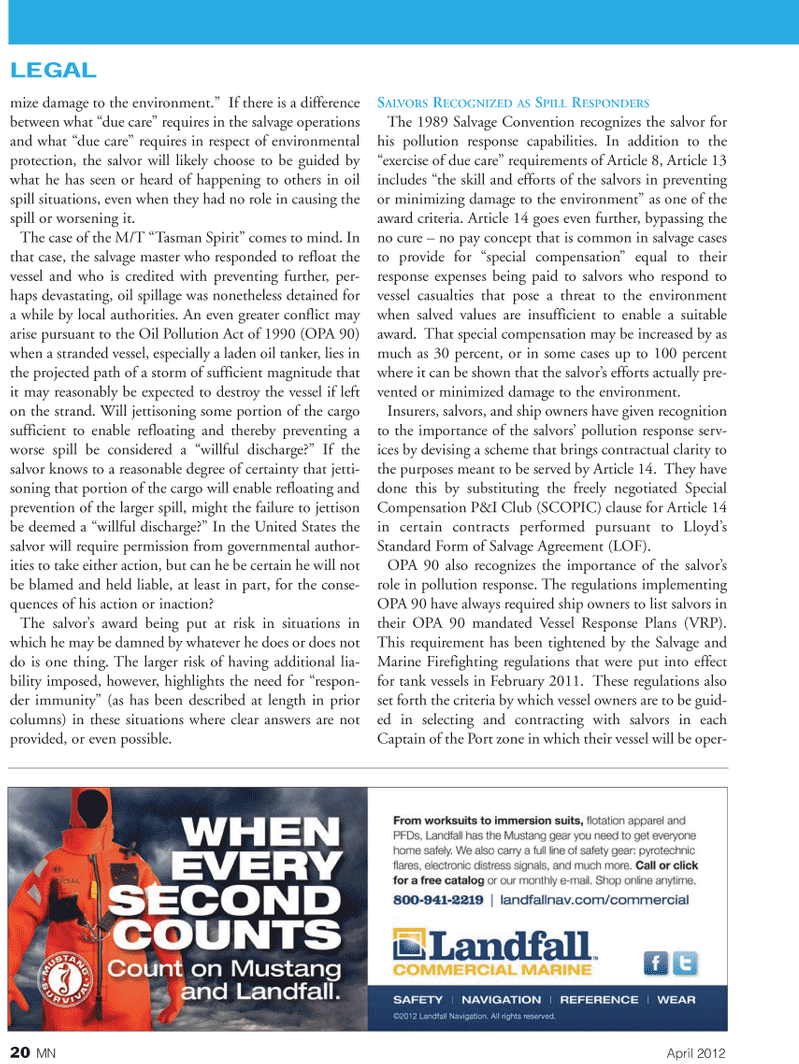
Page 20: of Marine News Magazine (April 2012)
Offshore Service Operators
Read this page in Pdf, Flash or Html5 edition of April 2012 Marine News Magazine
20MNApril 2012mize damage to the environment.? If there is a difference between what due care? requires in the salvage operations and what due care? requires in respect of environmental protection, the salvor will likely choose to be guided by what he has seen or heard of happening to others in oil spill situations, even when they had no role in causing the spill or worsening it.The case of the M/T Tasman Spirit? comes to mind. In that case, the salvage master who responded to refloat the vessel and who is credited with preventing further, per- haps devastating, oil spillage was nonetheless detained for a while by local authorities. An even greater conflict may arise pursuant to the Oil Pollution Act of 1990 (OPA 90) when a stranded vessel, especially a laden oil tanker, lies in the projected path of a storm of sufficient magnitude that it may reasonably be expected to destroy the vessel if left on the strand. Will jettisoning some portion of the cargo sufficient to enable refloating and thereby preventing a worse spill be considered a willful discharge?? If the salvor knows to a reasonable degree of certainty that jetti- soning that portion of the cargo will enable refloating and prevention of the larger spill, might the failure to jettison be deemed a willful discharge?? In the United States the salvor will require permission from governmental author- ities to take either action, but can he be certain he will not be blamed and held liable, at least in part, for the conse- quences of his action or inaction?The salvors award being put at risk in situations in which he may be damned by whatever he does or does not do is one thing. The larger risk of having additional lia- bility imposed, however, highlights the need for respon- der immunity? (as has been described at length in prior columns) in these situations where clear answers are not provided, or even possible. SALVORS RECOGNIZEDAS SPILL RESPONDERSThe 1989 Salvage Convention recognizes the salvor for his pollution response capabilities. In addition to the exercise of due care? requirements of Article 8, Article 13 includes the skill and efforts of the salvors in preventing or minimizing damage to the environment? as one of the award criteria. Article 14 goes even further, bypassing the no cure ? no pay concept that is common in salvage cases to provide for special compensation? equal to their response expenses being paid to salvors who respond to vessel casualties that pose a threat to the environment when salved values are insufficient to enable a suitable award. That special compensation may be increased by as much as 30 percent, or in some cases up to 100 percent where it can be shown that the salvors efforts actually pre- vented or minimized damage to the environment. Insurers, salvors, and ship owners have given recognition to the importance of the salvors pollution response serv- ices by devising a scheme that brings contractual clarity to the purposes meant to be served by Article 14. They have done this by substituting the freely negotiated Special Compensation P&I Club (SCOPIC) clause for Article 14 in certain contracts performed pursuant to Lloyds Standard Form of Salvage Agreement (LOF). OPA 90 also recognizes the importance of the salvors role in pollution response. The regulations implementing OPA 90 have always required ship owners to list salvors in their OPA 90 mandated Vessel Response Plans (VRP). This requirement has been tightened by the Salvage and Marine Firefighting regulations that were put into effect for tank vessels in February 2011. These regulations also set forth the criteria by which vessel owners are to be guid- ed in selecting and contracting with salvors in each Captain of the Port zone in which their vessel will be oper- LEGAL

 19
19

 21
21
